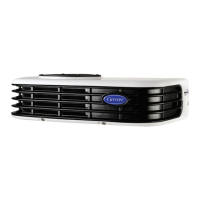
Do you have a question about the Carrier TRANSICOLD Neos 100S and is the answer not in the manual?
| Brand | Carrier TRANSICOLD |
|---|---|
| Model | Neos 100S |
| Category | Automobile Accessories |
| Language | English |
Shows the location of the unit's nameplate for identification.
Covers Lockout/Tagout, enclosed moving parts, and fan start-up hazards.
Warns about refrigerant contact and recommends professional service.
Advises checking battery cables for wear, damage, and secure routing.
Explains the unit's operation when connected to an external power source.
Describes how the unit maintains temperature via clutch and fan operation.
Details automatic and manual defrost cycles and display indicators.
Identifies the physical components of the control panel, including display and buttons.
Explains the function of the green and red LEDs for unit operation and malfunctions.
Details the information shown on the 3-digit display screen, such as temperature and messages.
Describes how to use the ON/OFF, SET, MINUS/PLUS, and DEFROST keys.
Clarifies the operational meaning of the °C/°F, REGULATION, and ALARM LEDs.
Steps for starting the vehicle engine and then the refrigeration unit.
Instructions to check and adjust the temperature set point after starting.
How to turn off the unit for short stops using the vehicle ignition key.
Procedure for shutting down the unit manually using the OFF key for extended periods.
Steps to view the current temperature set point on the display.
How to change the desired temperature using the SET and +/- keys.
Verifying box temperature is 40°F or lower before initiating defrost.
Procedure to start a manual defrost cycle using the DEFROST key.
Steps to shut down the unit and access defrost interval settings.
Options for inhibiting defrost, automatic, or fixed interval settings.
Steps to enter the functional parameters to configure the minimum set point lock.
Procedure to set the minimum temperature pull-down value and its available options.
How to configure the differential parameter and its available values.
Configuring the Evaporator Fan Motor status in "Null" Mode.
How to validate and save the selected minimum set point and differential parameter values.
Steps to enter malfunction codes by holding the SET key.
How to display active/passive alarms and the software version.
Procedure to view the unit's running hours (hourmeter).
Pre-cooling the box, evacuating humidity, and cleaning evaporator grills.
Guidelines for opening doors, selecting temperature, checking goods, and air circulation.
Explains the critical role of air circulation for product quality and preventing hot spots.
Recommendations for using pallets and stacking products for optimal airflow.
Emphasizes checking product temperature and the unit's limitation to maintain, not cool, warm loads.
Provides recommended set point ranges in °F and °C for various products.
Note on shutting down the unit during door openings to maintain cargo temperature.
Lists common problems and potential causes when the unit is not cooling or cooling insufficiently.
Troubleshooting high/low discharge and suction pressures in cooling mode.
Identifies causes for unit not heating or insufficient heating.
Solutions for automatic/manual defrost initiation failures or cycle issues.
Explains the different categories of alarms based on their behavior and display.
How to interpret the alarm indicator and navigate through alarm messages.
A table listing common alarm codes and their corresponding error descriptions.
Procedure to reset passive alarms and the maintenance interval message.
Lists fuses, their locations, ratings, and protective functions for the unit.
Warning about Lockout/Tagout procedures before replacing fuses.
Presents a schedule for initial, Service A, and Service B maintenance based on running hours.
Explains how service messages appear on the cab command display.
Details checks and replacements for initial service and recurring Service A tasks.
Outlines Service B tasks and recommended replacements every one or two years.
Important note on using only approved Polyolester (POE) compressor oil.
Guidelines for safe connection and disconnection from the power source in standby mode.
Details on cable specifications, grounding, and Ground Fault Protection Devices for 230V supply.
Information on finding 24-hour emergency service centers via directories and websites.
Highlights capabilities of the Carrier Transicold Dealer Locator App for finding dealers and services.
Contact information for the 24-hour Action Line for immediate assistance.